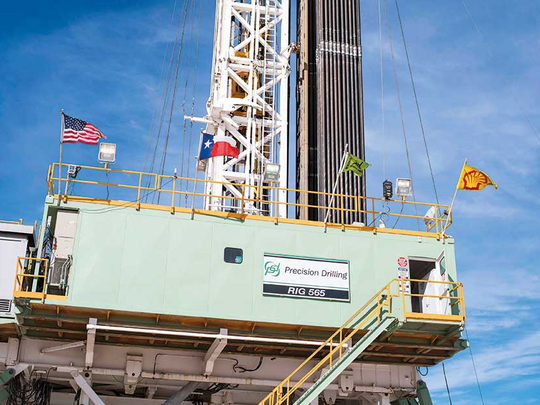
New York: A surge in hedging contracts is helping US shale drillers ride out the turmoil in global oil markets this year. Next year may not be so easy.
As of March, the biggest explorers had hedged 28 per cent of this year’s production, according to Warren Russell and Michael Cohen of Barclays Plc. Those contracts, which lock in future payments, are expected to help US output reach a “multi-decade high by December, within sights of the all-time high reached in 1970,” the analysts wrote in a note to clients.
There are no guarantees for 2018, however, when most of the hedges expire. The falling price of crude, which has dropped 10 per cent since the start of the year, is taking its toll, according to Francisco Blanch, head of commodities research at Bank of America Corp in New York.
“There was a lot of hedging when prices were between $50 and $55 [Dh183.50 and Dh201.85],” Blanch said in a telephone interview on Tuesday. “Now that it’s trading under $50, not many people are rushing to hedge.”
West Texas Intermediate crude rose Tuesday on reports that Libya had curbed shipments from its biggest oilfield, tempering worries about a global supply glut. Still, prices have given back all of their gains since an OPEC-led deal last year to trim production. The rally faltered as the cuts failed to quickly dissipate crude stockpiles and rig counts rose in the US.
“Oil futures prices must recover before producers can lock in prices over $55 a barrel for next year, which is what we think is needed” to fund significant new growth, Andy McConn, a Houston-based analyst at Wood Mackenzie Ltd, said in a research report released by the consultant on Monday.
Remarkable surge
Last year’s surge in hedging was “remarkable,” said Roy Martin, another Wood Mackenzie analyst, in a telephone interview. Historically, shale companies have locked in payments for no more than 30 per cent of their output each year; they’re already close to that level and could blow past it if oil prices recover, he said, assuring a steady stream of income that would help boost supplies more.
“It definitely isn’t the best news if you’re Opec or long on oil prices,” Martin said.
With oil faltering, Opec and other major producers have discussed extending production cuts into the second half of the year. A final decision is expected in May. If the group goes ahead, prices should rise and shale companies will add more hedges, Martin said. If there’s no deal, “there’s going to be a lot of people kicking themselves that they didn’t hedge more when they had the chance.”
Constructive view
Newfield Exploration Co, which concentrates on Oklahoma shale, has signed contracts for about a third of its production this year but has few hedges for 2018, Chief Executive Officer Lee Boothby told Bloomberg TV in an interview at the Scotia Howard Weil Energy Conference in New Orleans. It’s a sign of the company’s “constructive” view about future prices, he said.
Parsley Energy Inc, on the other hand, has locked in payments for about half of its 2018 production, CEO Bryan Sheffield said in an interview Tuesday at the conference. The company is already adding contracts for 2019 at about $50 a barrel, he said in a Bloomberg TV interview.
US drillers added hedging contracts for 648,000 barrels of crude in 2016’s final quarter, the biggest increase in more than a year, according to the Wood Mackenzie report, which tracked 33 of the biggest shale producers. The agreements locked in payments as high as $60 a barrel this year, and mean output is likely to continue growing even as the threat of more US supplies has pushed prices back below $50.
The volume of new hedges rose by 33 per cent from 2016’s third quarter to the fourth, when Opec, Russia and other major exporters agreed to slash supplies to try to prop up prices. Among US companies, Apache Corp and Anadarko Petroleum Corp. added the most hedges, accounting for 28 per cent of new volumes, the report found.
Those hedges will help companies “plug any budget deficits” caused by the fall in prices and could “worsen the US supply glut,” McConn said in Wood Mackenzie’s report.












